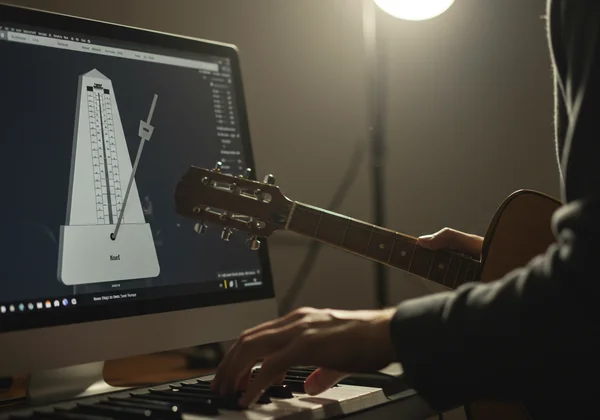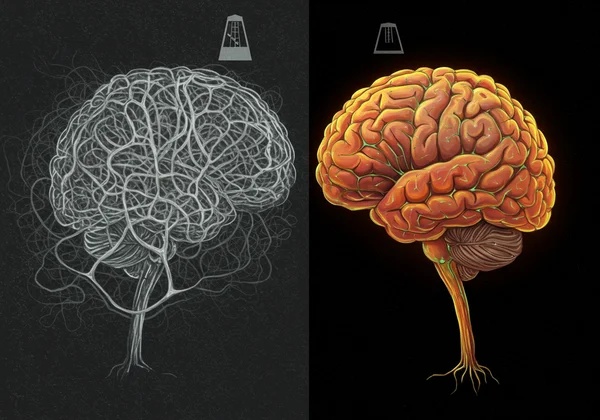Unlocking Perfect Timing: How Our Online Metronome Improves Rhythm
Have you ever felt that silent struggle during practice? You play all the right notes, but something feels off. Your timing rushes ahead, or maybe it drags slightly behind the beat. This common frustration is the final barrier between good playing and great musicianship. The solution isn't just more practice; it's smarter practice. This is where we explore how metronomes improve rhythm, looking deep into the science of perfect timing. But can a metronome improve my rhythm in a truly fundamental way? The answer lies in the fascinating connection between sound, your brain, and your body.
The journey to rhythmic mastery is scientific, involving rewiring your neural pathways for precision. It's about transforming an unsteady internal pulse into a rock-solid foundation. With a reliable tool, you can start this process today. Before diving in, open our online metronome and set it to a comfortable tempo. Let it click in the background as you discover the powerful changes you're about to unlock.

The Brain's Internal Clock: How We Perceive & Process Rhythm
At the core of our ability to keep time is the brain's internal clock, a complex network involving areas like the cerebellum and basal ganglia. This system allows us to anticipate beats, synchronize our movements, and feel the groove in music. However, this internal clock isn't always perfectly calibrated. It can be influenced by our emotions, focus, and even our physical state, leading to inconsistencies in our timing.
A metronome is an unwavering external reference point for the brain. It provides a steady, predictable pulse that trains and regulates this internal clock. Consistently exposing our brain to a perfect beat teaches it what perfect time feels and sounds like, creating a more accurate standard for our performance.
Understanding Auditory-Motor Synchronization
Have you ever tapped your foot to a song without thinking about it? That's auditory-motor synchronization in action. This is the brain's natural ability to align physical movements with an external auditory rhythm. A metronome leverages this instinctual process for deliberate practice. Each click sends a clear signal to your auditory cortex, which then communicates with your motor cortex to coordinate your muscles.
This continuous feedback loop is crucial. When you play an instrument, dance, or even run, the metronome's click provides immediate, objective feedback. If your action doesn't align with the click, your brain registers the error and makes micro-adjustments. Over time, this refines the connection between what you hear and how you move, making your actions more precise and rhythmically accurate. Using a simple BPM tool is the first step in strengthening this vital connection.

Why Our Natural Timing Can Drift: The Challenge of Maintaining Consistency
Even the most experienced performers find their internal timing can drift. This is a natural human tendency. Factors like fatigue, anxiety, or the technical difficulty of a piece can cause us to rush or drag. Our brain is juggling numerous tasks—reading music, controlling technique, and expressing emotion—and maintaining a steady tempo can easily fall by the wayside.
This is why a metronome is an indispensable tool, not a crutch. It acts as an anchor, preventing this drift. By practicing with an external, objective timekeeper, you build the discipline to maintain a steady pulse even when faced with challenging passages or performance pressure. It forces you to confront and correct timing inaccuracies, ensuring that your internal clock remains stable and reliable under any circumstances.
The science of deliberate practice: Rewiring Your Rhythmic Pathways
Merely practicing isn't enough to achieve mastery; it requires what psychologists call "deliberate practice." This involves focused, systematic effort designed to improve a specific skill. When it comes to rhythm, the metronome is the ultimate tool for deliberate practice. It transforms a vague goal like "get better at timing" into a measurable, actionable process.
By setting a specific tempo on a free metronome tool, you create a controlled environment where you can isolate and address rhythmic weaknesses. This focused attention on timing, guided by the metronome's steady beat, is what stimulates profound changes in your brain's structure and function. It's not just about playing in time; it's about fundamentally changing how your brain processes rhythm.
Neuroplasticity in Action: Adapting to External Rhythmic Cues
The brain's ability to change and adapt based on experience is called neuroplasticity. This is the biological mechanism that makes learning possible. When you practice with a metronome, you are actively engaging in a neuroplastic process. The consistent, external beat forces your brain to build and strengthen the neural connections responsible for time perception and motor control.
Think of it like forging a new path in a forest. At first, the path is rough and requires conscious effort to navigate. But with repeated travel, it becomes a well-worn, easy-to-follow trail. Similarly, consistent metronome practice strengthens the "rhythmic pathways" in your brain, making precise timing less of a conscious effort and more of an automatic, ingrained skill.

The Optimal Tempo: Why Slow Practice with a Metronome Builds Lasting Skills
It's a common temptation to want to play everything fast. However, the most effective way to build a solid rhythmic foundation is to practice slowly. Practicing at a slow tempo with a metronome gives your brain the processing time it needs to absorb every detail of the music and your movements. It allows you to focus on the space between the notes, ensuring each one is placed perfectly in time.
This slow, deliberate repetition helps encode clean, accurate motor patterns into your muscle memory. If you practice with mistakes at a fast tempo, you're just teaching your brain to be fast and sloppy. By slowing down and using an online metronome to ensure every note is perfect, you build a flawless foundation that remains intact even when you gradually increase the speed.

Building rhythmic muscle memory: From Conscious Effort to Automatic Flow
The ultimate goal of rhythmic practice is to reach a state where you no longer have to consciously think about keeping time. This is where timing becomes part of your "muscle memory"—an automatic, intuitive process. This frees up your mental energy to focus on the more expressive and emotional aspects of your performance.
A metronome is the bridge between conscious effort and automatic flow. By consistently drilling exercises, scales, or musical pieces with a metronome, you are programming your body to execute movements with perfect timing. The steady click becomes an internalized pulse, guiding your muscles until the rhythm is as natural as breathing.
Motor Learning and Proprioception: The Body's Role in Timing
Rhythm isn't just in your head; it's in your body. Motor learning is the process by which we develop smooth, accurate movements, while proprioception is your body's awareness of its position in space. A metronome enhances both. It forces you to synchronize the physical motions of playing an instrument or dancing with an external beat, refining your physical control.
This process calibrates your proprioceptive sense. You begin to feel where the beat is in your hands, your feet, and your entire body. This physical embodiment of the pulse is what creates truly solid rhythm. It's the difference between intellectually knowing where the beat is and physically inhabiting it. You can begin this process now by trying the tap tempo feature to find a rhythm you feel and then practicing with it.
Eliminating Rushing & Dragging: Calibrating Your Internal Pulse
Two of the most common timing problems are rushing (speeding up) and dragging (slowing down), especially during difficult or exciting parts of a performance. These habits are often subconscious, making them difficult to correct without an objective reference. The metronome is brutally honest; it instantly reveals these tendencies.
By forcing you to stay locked into its unwavering tempo, the metronome helps you identify exactly where and why you tend to speed up or slow down. Conscious practice focused on these specific moments recalibrates your internal pulse. Over time, you learn to resist the urge to rush through an exciting passage or drag during a slower one, leading to a performance that is powerful, controlled, and perfectly in time.
Beyond the Click: Internalizing Rhythm and Fostering Musicality
Some people fear that practicing with a metronome will make their performance robotic or unmusical. In reality, the opposite is true. Mastering time with a metronome doesn't restrict your musicality; it unleashes it. Once your sense of time is solid and internalized, you have the freedom to play with the rhythm for expressive effect—a concept known as rubato—while always being able to return to a steady pulse.
The metronome is a training tool, not a permanent fixture. The goal is to use it to build such a strong internal sense of time that you no longer need it. It provides the fundamental grid upon which you can paint your musical ideas with confidence and creativity.
Developing Your Inner Metronome: The Power of Silent Bar Practice
An advanced technique to test and strengthen your internal clock is "silent bar" practice. Using a metronome app or a customizable online metronome, you can set it to play for one measure and then be silent for the next. Your task is to continue playing in perfect time during the silent measure and land perfectly on the downbeat when the click returns.
This exercise is incredibly effective for developing a truly independent and reliable internal pulse. It forces you to move beyond simply reacting to the click and start genuinely generating the time yourself. It’s the final step in graduating from dependence on the metronome to a true mastery of rhythm.

Psychological Benefits: Enhanced Focus, Discipline, and Performance Confidence
The benefits of metronome practice extend beyond just timing. The focused attention required to play perfectly with a metronome is a form of mindfulness training. It builds your ability to concentrate for extended periods, a skill that benefits every aspect of your life. It also instills a sense of discipline and patience, as progress is made through slow, steady, and deliberate work.
Most importantly, knowing your rhythm is solid gives you immense performance confidence. When you don't have to worry about your timing, you can perform with more freedom, power, and expression. This confidence allows your true artistry to shine through, unhindered by technical insecurities.
Unleash Your Inner Rhythm: Start Your Scientific Practice Journey Today
Improving your rhythm is not a matter of luck or innate talent; it's a science. By understanding how your brain perceives time and leveraging tools that facilitate deliberate practice, you can systematically rewire your neural pathways for perfect timing. The metronome is your personal laboratory for this experiment, providing the consistent, objective feedback needed to transform your internal clock from unreliable to unwavering.
From building auditory-motor synchronization to forging rhythmic muscle memory, every click is a step toward mastery. You are not just practicing notes; you are building a more focused, disciplined, and confident mind. The journey from conscious struggle to automatic flow begins with a single, steady beat. Ready to start? Visit our homepage and use our free, customizable online metronome to begin your scientific practice journey right now.
Frequently Asked Questions About Metronome Practice
Can a metronome truly improve my natural rhythm and timing?
Absolutely. A metronome works by providing your brain with a perfect, external reference for time. Through a process called neuroplasticity, consistent practice with this reference helps rewire the neural pathways responsible for your internal clock, leading to significant, lasting improvements in your natural sense of rhythm and timing.
How exactly does consistent metronome practice change my brain and muscle memory?
Consistent practice strengthens the connection between your auditory and motor systems. Each time you synchronize your movements to the metronome's click, you are reinforcing the neural circuits for that action. Over time, this makes the movement more efficient and automatic, encoding it into your muscle memory and reducing the conscious effort needed to maintain a steady tempo.
What does BPM stand for in music, and why is it important for practice?
BPM stands for Beats Per Minute. It is a unit of measurement for tempo, indicating the speed of a piece of music. Using specific BPM settings during practice is crucial because it allows you to measure your progress objectively, work on difficult passages at a manageable speed, and ensure you are playing the music at the composer's intended tempo.
How can I use Our Online Metronome to Effectively Implement These Scientific Principles in My Practice?
Our online metronome is designed for effective, scientific practice. You can start by using our tool to find a slow, comfortable BPM for a piece you're working on. Use the customizable time signature and beat subdivision features to tackle complex rhythms. As you improve, gradually increase the BPM to build speed without sacrificing accuracy. For an advanced challenge, try the silent bar technique mentioned earlier. The best way to start is to simply set your BPM and begin your focused practice session today.